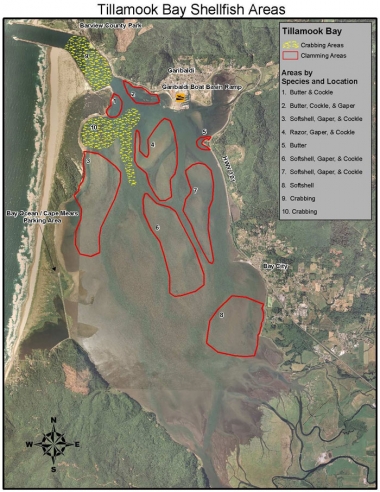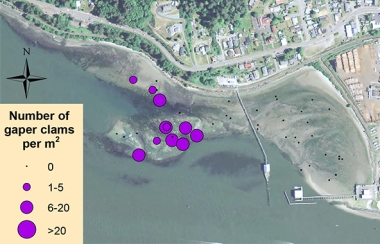
Where to crab & clam in Tillamook Bay
Crabbing can be good year-round but the best catches are in the winter. Tidal flats throughout the bay produce lots of gapers, cockles and softshell clams.

General crab and clam map
Areas
Area 1
Can be reached by either boat or bank/walk-in access. This area is rocky and a garden fork (heavy tined) works best, or a combination of fork and shovel. Bank access to this area is found at the end of the Bay Ocean Peninsula/Cape Mears Lake parking lot located off Bayocean Rd. 7.3 miles north of Hwy 131; it will then be a mile-plus walk or bike ride on a gravel/rock road along the inside edge of the bay. This area is dominated by cockle clams, though butter clams can also be found.
Area 2
Can be reached by either boat or bank/walk-in access. This is one of the closest areas from the boat basin. Bank access to this area can be obtained through the boat basin, or from the parking area at the end of 12th St. in Garibaldi. This area is rocky and a garden fork (heavy tined) works best, or a combination of fork and shovel. A good mix of butter, cockle and gaper clams can be found here.
Area 3
A large sandy bar that can be reached by either boat or bank/walk-in. Bank access is the same as Area 1. This area is a good mix of softshell, gaper, and cockles. Shovels and clam guns will work best for digging gapers and softshell, while cockles can be raked or handpicked off the surface.
Area 4
Contains two sand bars and will require a boat for access. This area is sandy so you’ll want to use shovels or clam guns. Gaper and cockle clams are the most abundant in this area, although razor clams can also be found on the northern tips of these bars.
Area 5
Can be reached easiest by bank/walk-in from pull-outs along Hwy 101, approximately 1.5 miles south of Garibaldi at Hobsonville Point. This area is rocky and a fork works best, or a combination of fork and shovel. Butter clams are most likely found here.
Area 6 and 7
Large sandy bars that require a boat for access. Shovels and clam guns will work best for digging gapers and softshell while cockles can be raked, or handpicked off the surface.
Area 8
Will require a boat for access. This area is a large mud flat containing mostly softshell clams, and walking can be difficult. Use shovels or clam guns for digging.
Area 9 and 10
Will require a boat for crabbing. Pots may be set anywhere within these areas, but use caution to avoid direct placement in navigation channels.
Detailed clamming maps
The ODFW SEACOR project
The ODFW SEACOR project conducts bay clam population and habitat studies in the bays along the coast of Oregon. A primary focus is to document the abundance and preferred habitat of several popular bay clam species. These include butter clams, cockle clams, gaper clams, and native littleneck clams.
SEACOR is funded by recreational shellfish license fees, meaning that clammers and crabbers are directly contributing to research on the resources they enjoy.
To learn more about SEACOR, and find additional detailed clamming maps for Tillamook, Netarts, Siletz, Yaquina, Alsea, and Coos bays, visit the SEACOR web page.
Boat launch
Garibaldi Boat Basin and Launch
Access off Hwy 101, in the city center, by turning west on 7th St. Crabbing can also be done off public piers at the south end of the Boat Basin or from the parking area at the end of 12th St. in Garibaldi.
Information provided is a result of past ODFW surveys, recent spot checks, and input from local residents. The purpose of this map is to provide the user with information and locations of recreational shellfish areas where the most likelihood of success may be found by species. Clam species identified within a particular area represent the most abundant found; other species may be present or may exist in areas not identified on the map. This is to be used as a reference as sandbars, clam beds, and species composition can shift over time. Always use caution when boating/crabbing in the lower bay as swift currents during tidal exchanges can occur, and result in loss of gear or cause boat to be pulled out to sea if mechanical problems arise.
Header photo by Kathy Munsel



